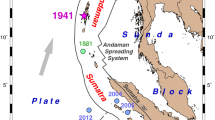Abstract
— T waves recorded at hydrophone and seismic stations following the Papua New Guinea earthquake of 17 July 1998 and its aftershocks show that a small event at 09:02 GMT featured source properties incompatible with an elastic dislocation of appropriate body-wave magnitude (m b=4.4). These include an exceptional duration (47 s at the Wake Island hydrophone station WK31), a spectrum rich in high frequencies (7 to 12 Hz), and a generally low spectral amplitude. These characteristics can be explained by the model of an underwater slump, accelerating from a standstill and eventually slowing down. The relocation of the 09:02 event is compatible with its location within an amphitheater inside which shipboard cruises in 1998 and 1999 documented the presence of a 4 – km3 geologically fresh slump. We propose that the slump took place at 09:02 on 17 July 1998, i.e., 13 minutes after the mainshock, and that it generated the locally catastrophic tsunami, whose properties (amplitude and distribution of runup; timing) could not be explained by a dislocation model.
Similar content being viewed by others
Author information
Authors and Affiliations
Rights and permissions
About this article
Cite this article
Okal, E. T Waves from the 1998 Papua New Guinea Earthquake and its Aftershocks: Timing the Tsunamigenic Slump. Pure appl. geophys. 160, 1843–1863 (2003). https://doi.org/10.1007/s00024-003-2409-x
Issue Date:
DOI: https://doi.org/10.1007/s00024-003-2409-x




